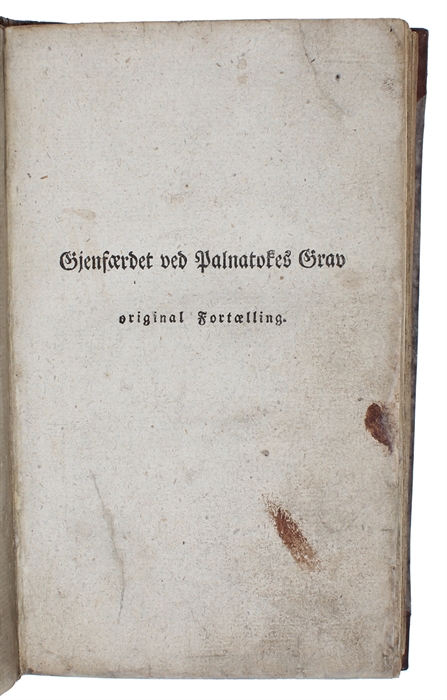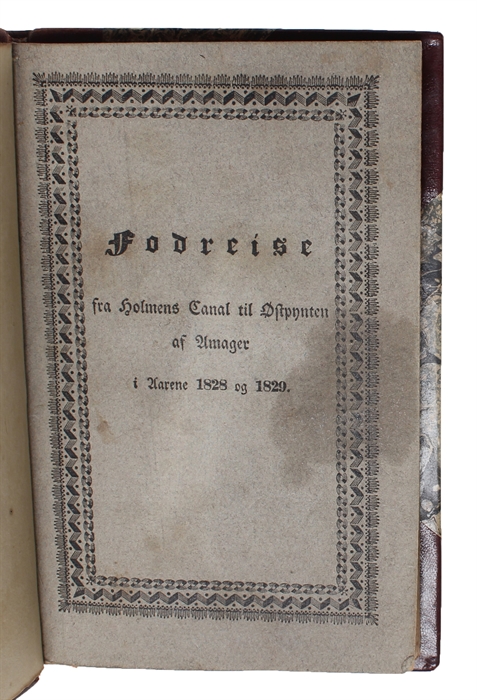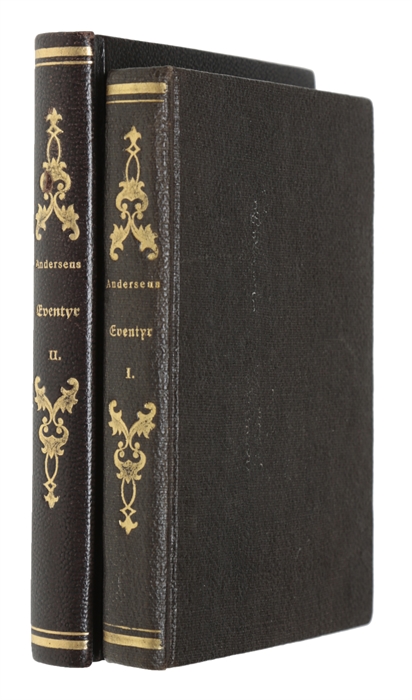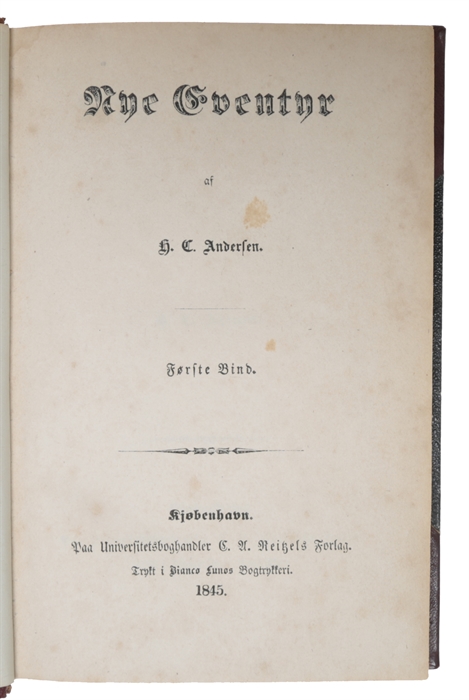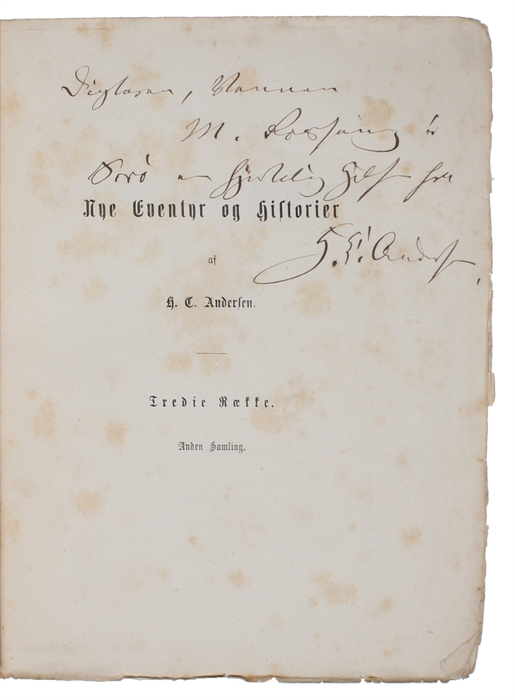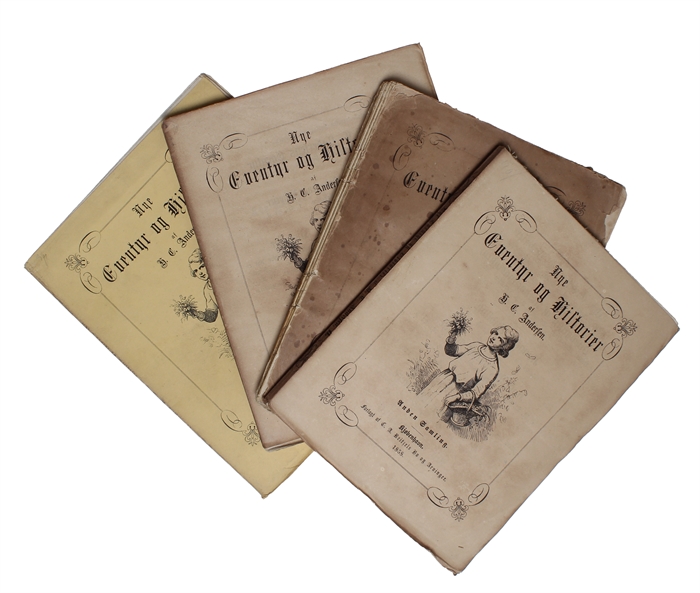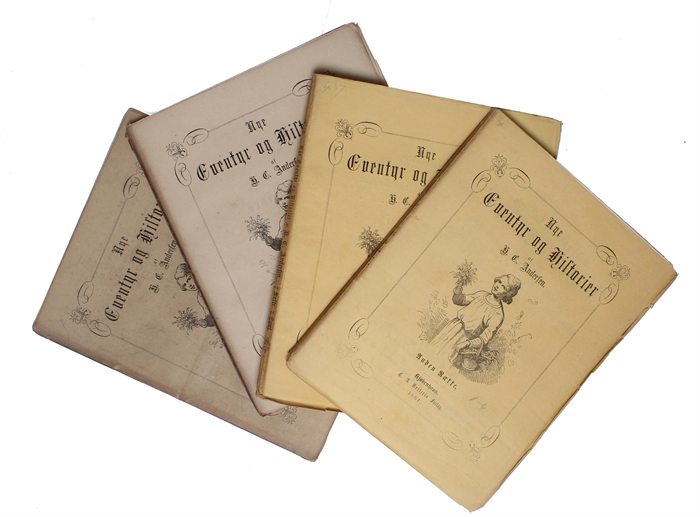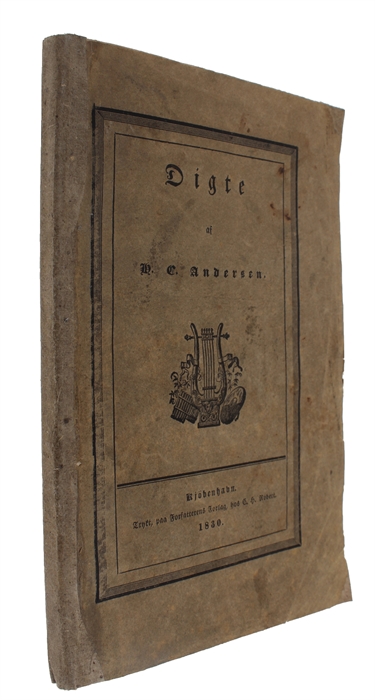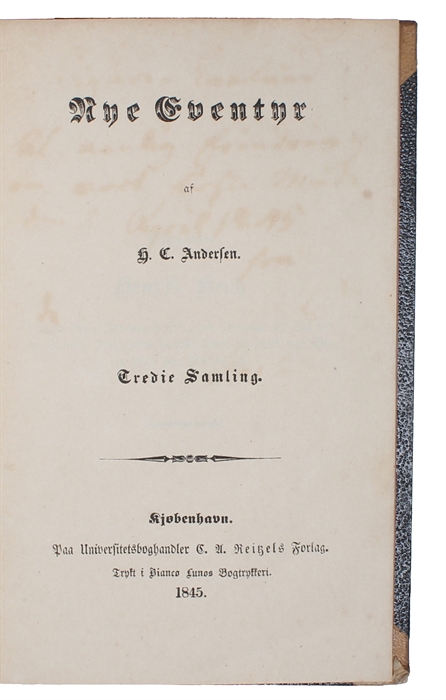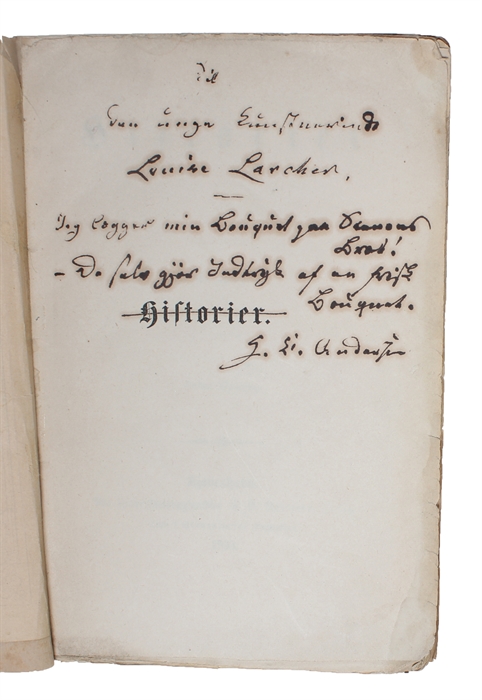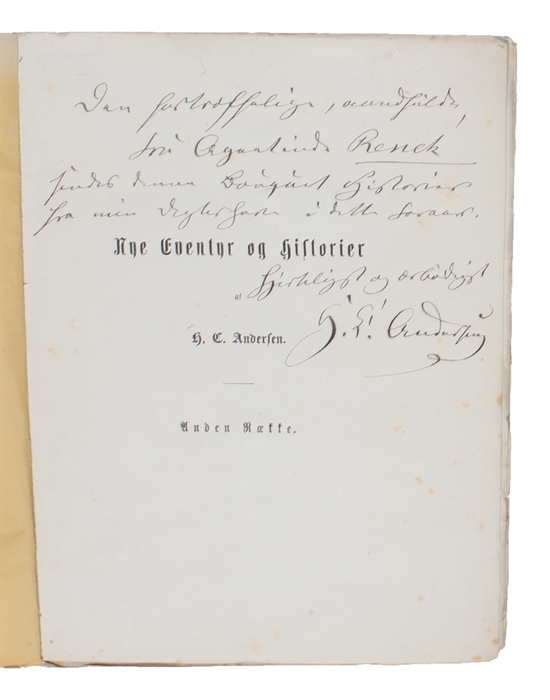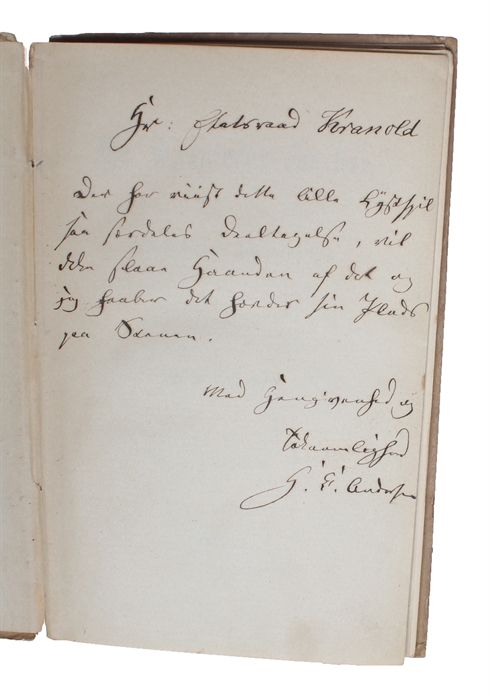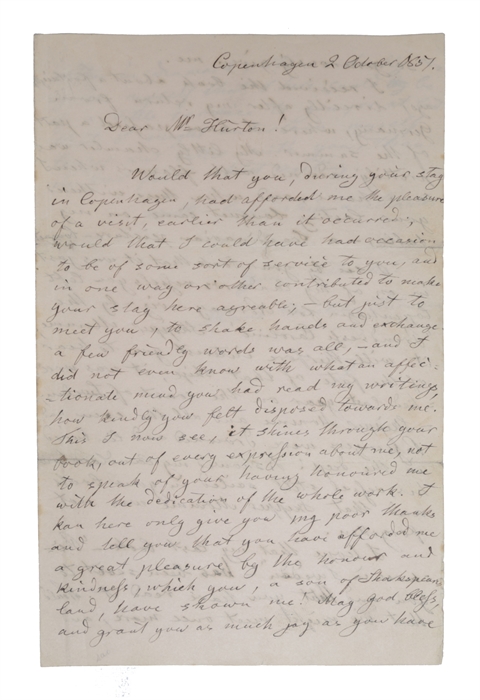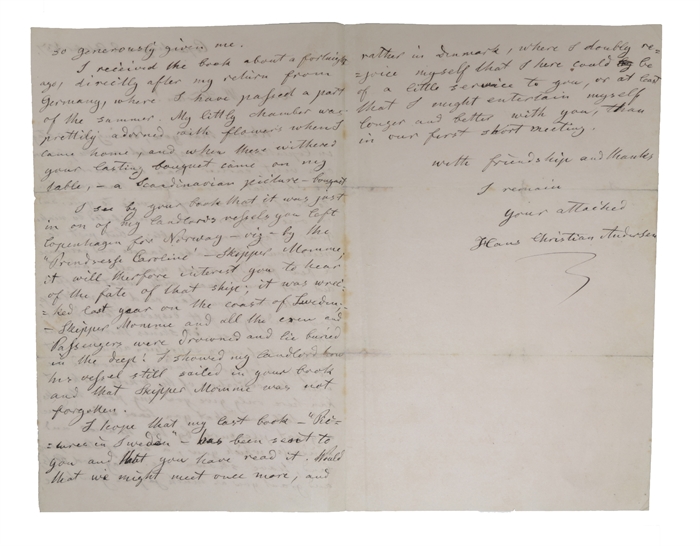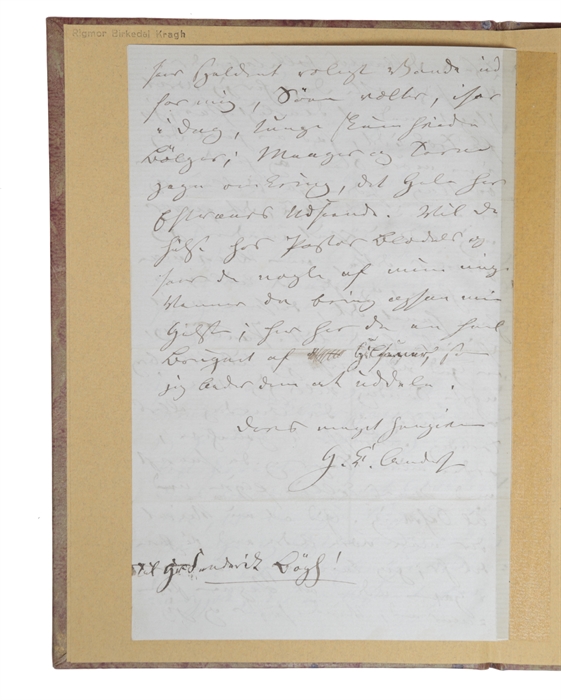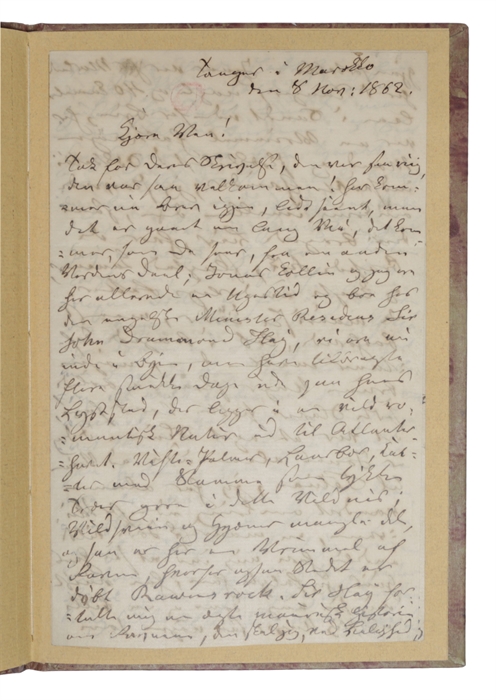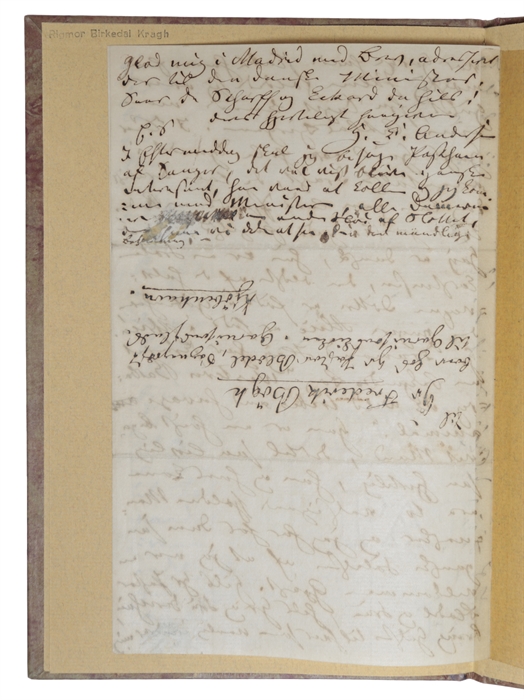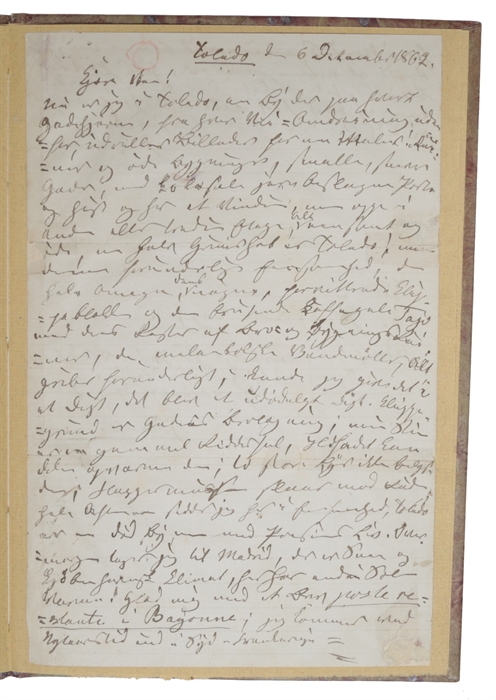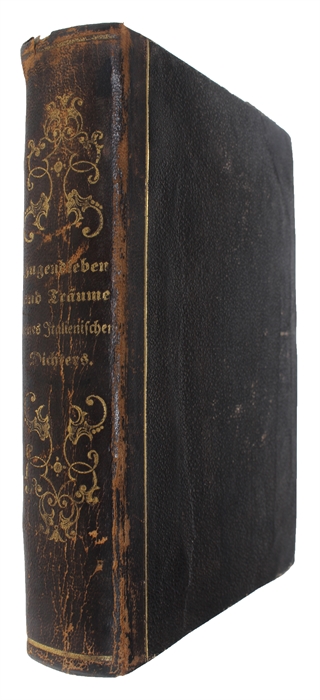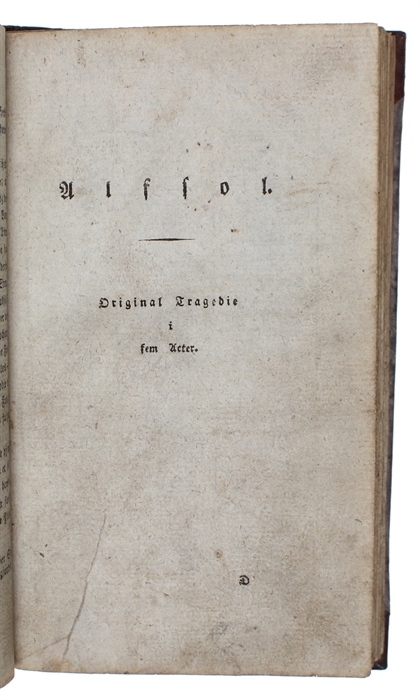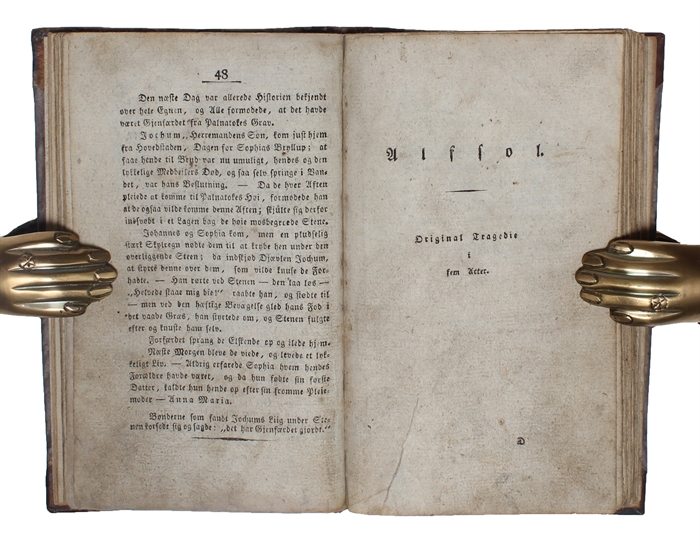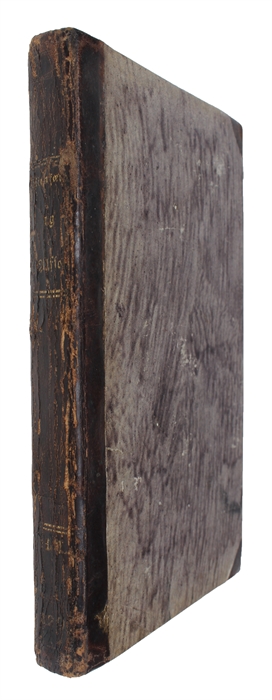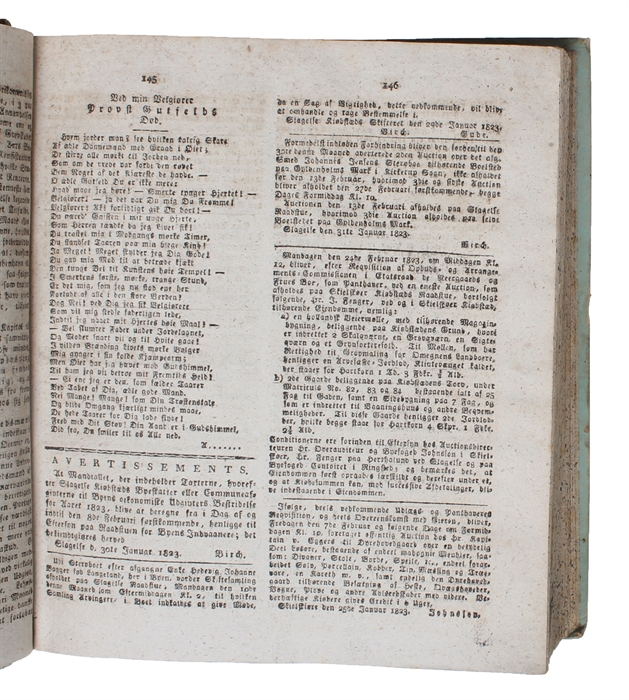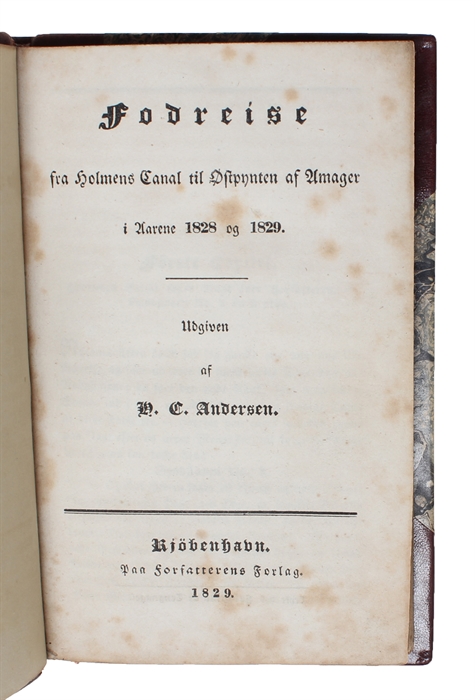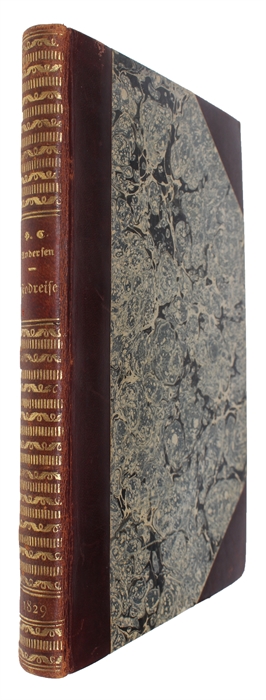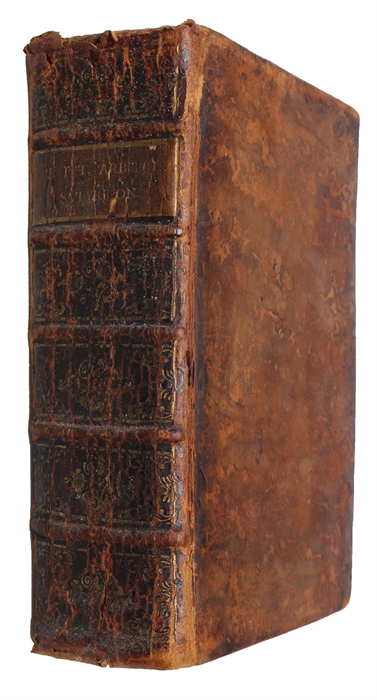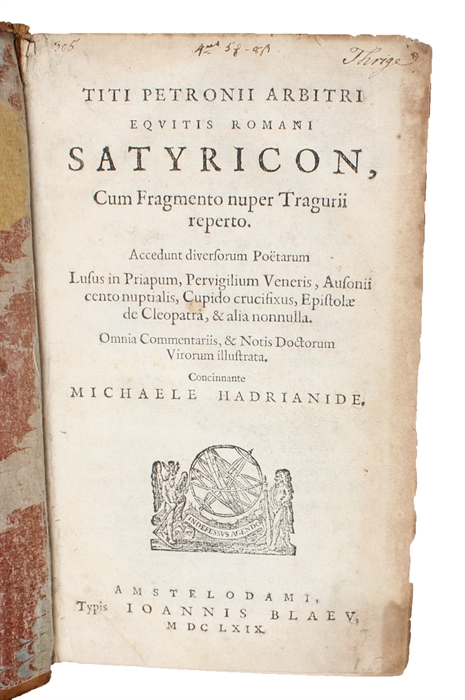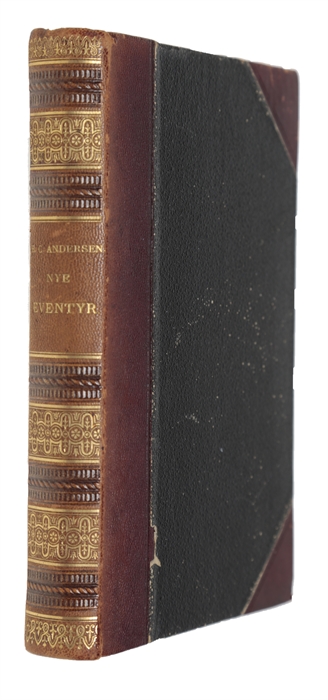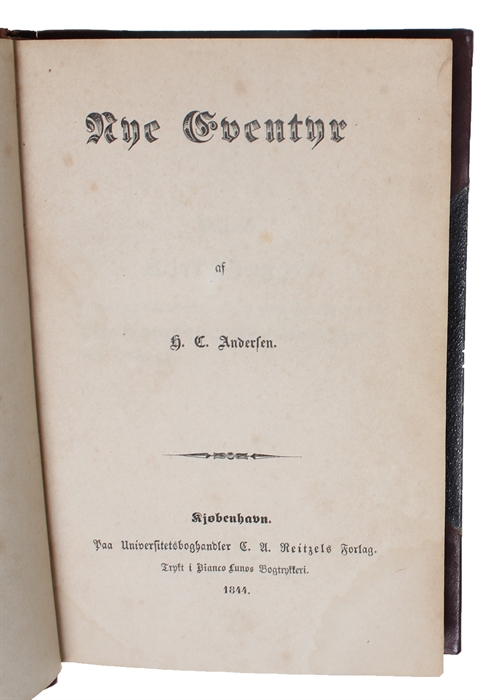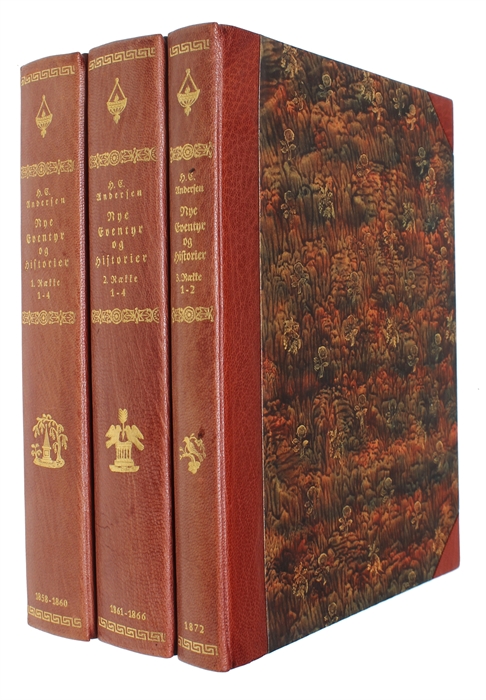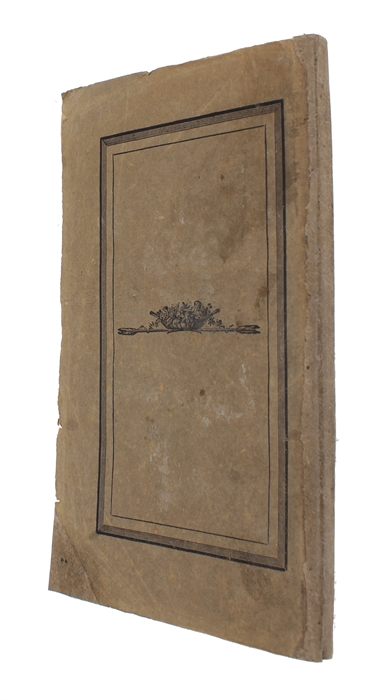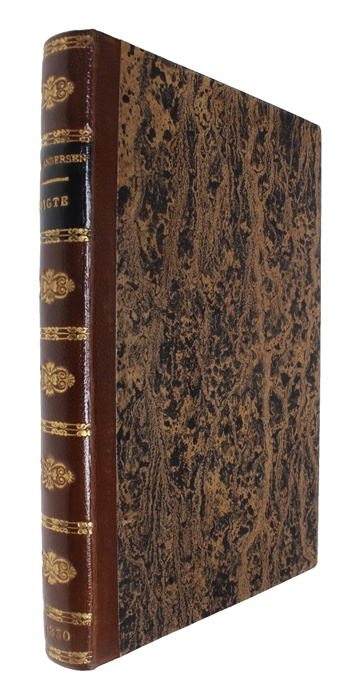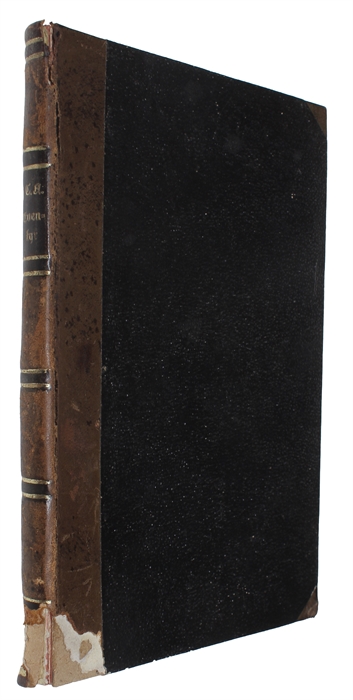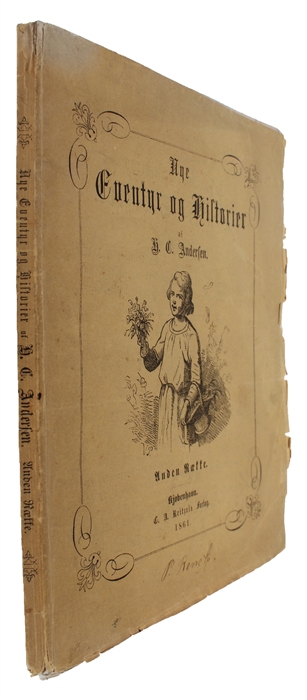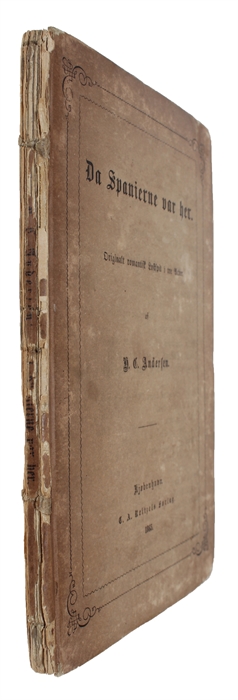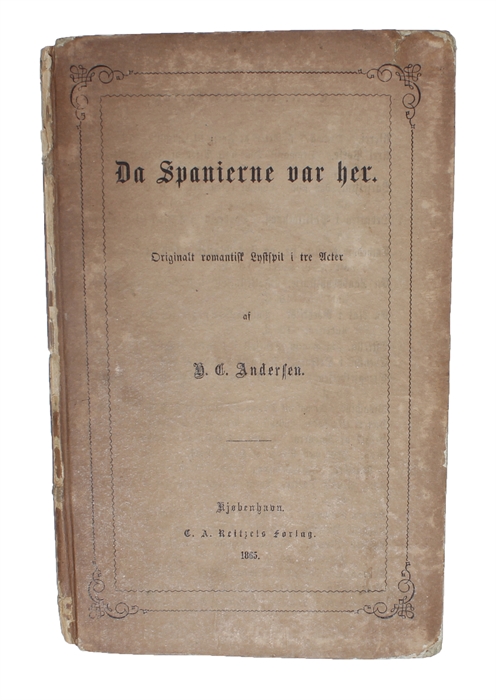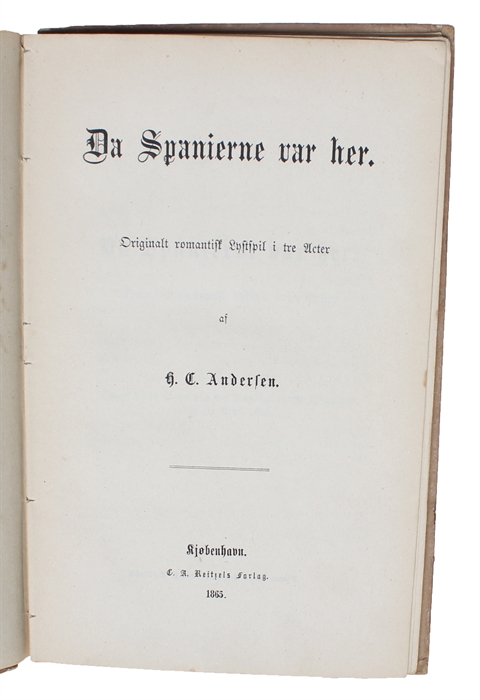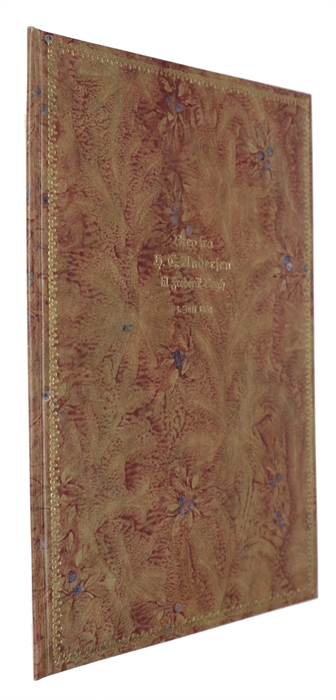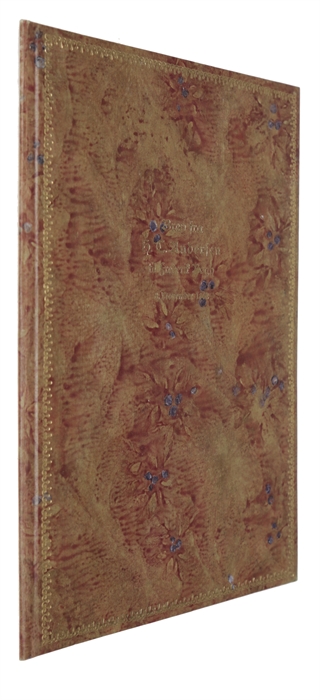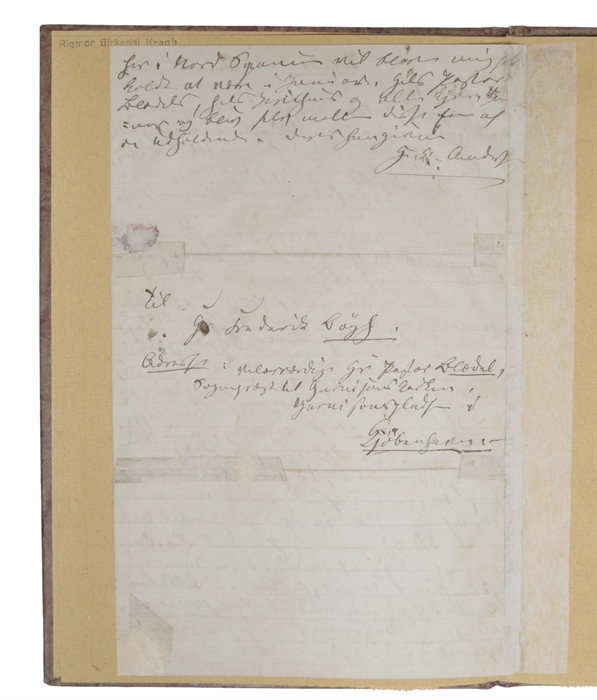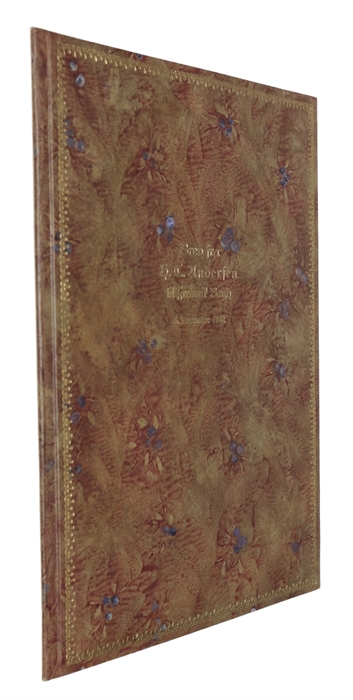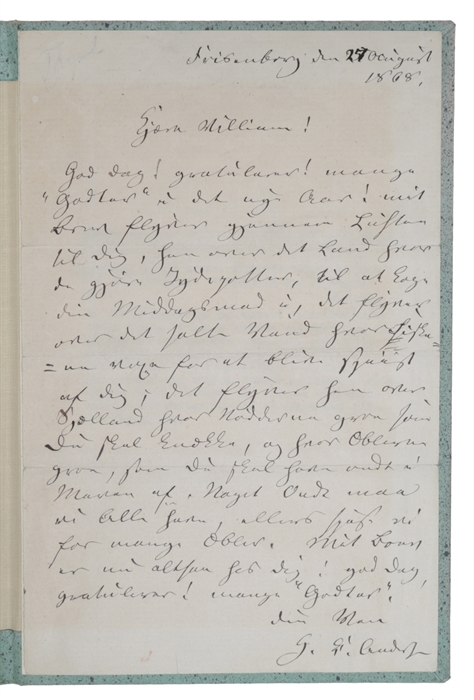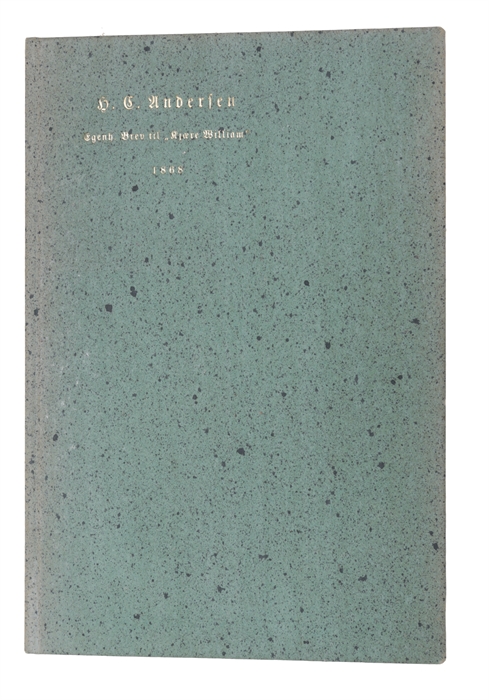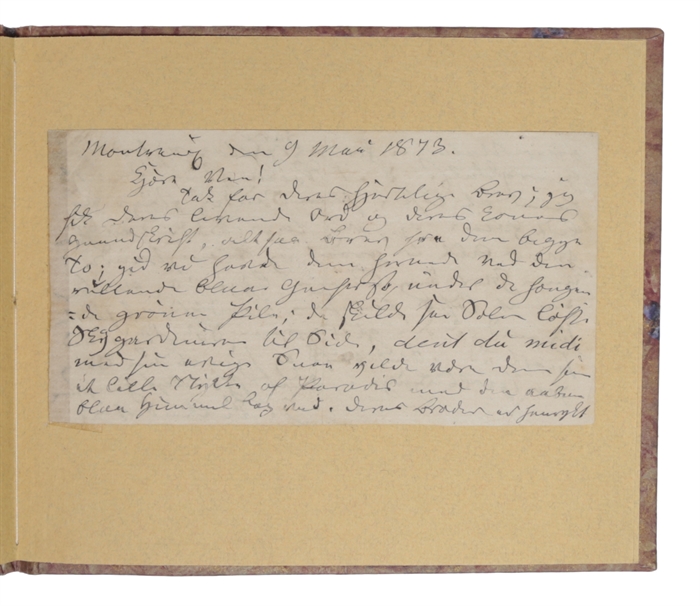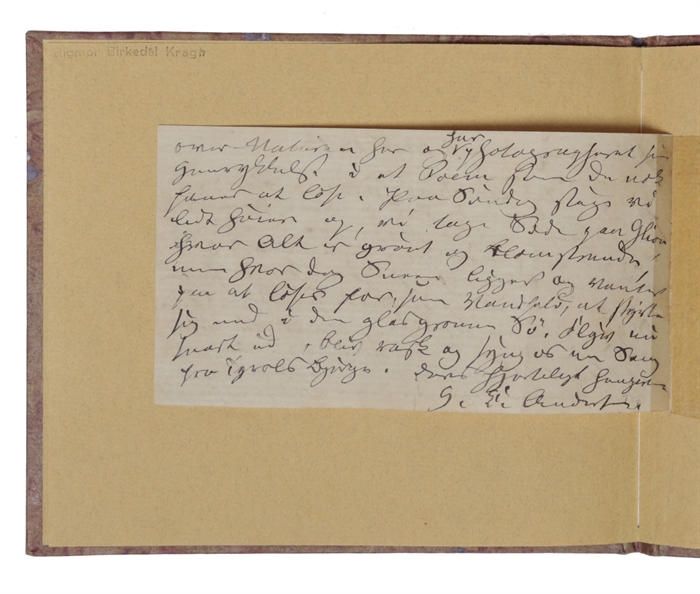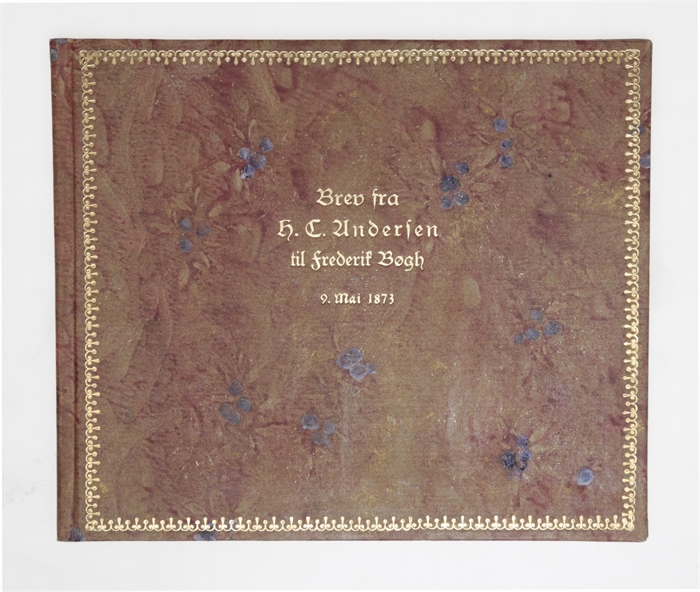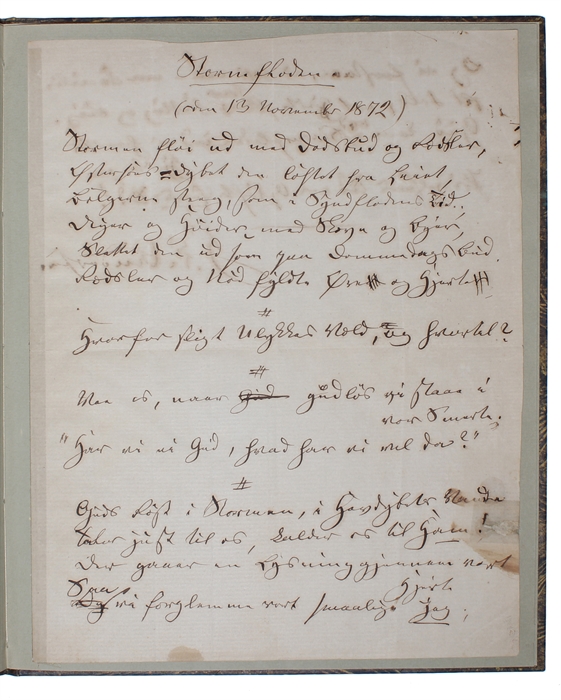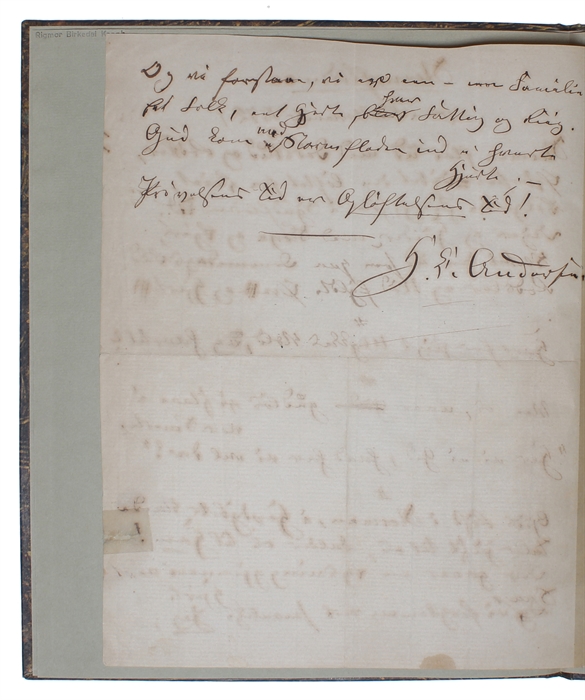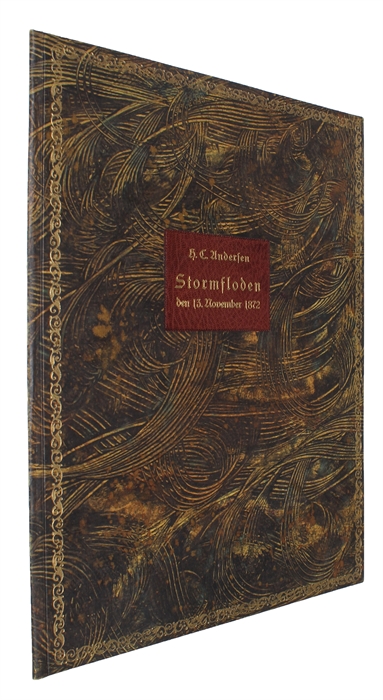MAGNIFICENT HANS CHRISTIAN ANDERSEN-COLLECTION
ANDERSEN, HANS CHRISTIAN.
A truly splendid and unique collection of 23 Hans Christian Andersen-items that together tell the true story of Andersen's life and sheds light on all aspects of his life and work. The collection is divided into the following (full descriptions below): 1. Debuts/earliest publications (see also 3.1.) 2. The three fairy tale collections/cycles 3. Presentation-copies (see also: 2.3.) 4. Letters 5. Manuscript 6. Books from Andersen's library 7. The three main translations
(1822) - 1872.
With the present Hans Christian Andersen-collection, we have aimed not at an exhaustive collection of ALL of his many writings nor at a LARGE collection, but at an exquisite, chosen collection that tells us the true story of Andersen's life. A collection that enlightens us about both the author and the man Hans Christian Andersen and that sheds light on all aspects of his life and work. A collection that epitomizes quality, scope, and importance, not merely numbers of items nor works that are not particularly important in his life's work. Every one of the 23 items in the present collection has been carefully chosen to represent a certain Aspect of Hans Christian Andersen at a certain time of his life, in an attempt to get as close to the great fairy tale author as possible. The items basically span his entire career - from his first book, published at the age of 17 (and only known in about 10 copies) to an original manuscript poem by the ageing author at the age of 67. The collection is divided into the following seven categories, and below follows a short preview and introduction to each. Upon request, a document with full, elaborate descriptions of each item will be provided.
The 23 carefully chosen and unique items cover his earliest publications that are of extreme scarcity, his three seminal fairy tale cycles that catapulted him into fame and created the genre of the fairy tale, for which he is now famous world-wide, five magnificent presentation-copies (among them an absolutely magnificent copy of his very first fairy tale, one of the best presentation-copies known) that each give us an insight into the poet Andersen and into his circle of friends, six splendid original letters that are all different in style and content and written from all over the world (among them one of the extremely rare letters known by him written in English, in Latin hand), an original manuscript, which is an extreme scarcity on private hands and something one may never come by again, two books from Andersen's own library, which is extremely rare to find, as only 75 such books are known and almost all of them are in institutional holdings, and finally the three main translations that ensured his fame in the rest of the world: the most important translations into German, English, and French respectively.
1. Debuts/earliest publications (see also 3.1.)
2. The three fairy tale collections/cycles
3. Presentation-copies (see also: 2.3.)
4. Letters
5. Manuscript
6. Books from Andersen's library
7. The three main translations
1. Debuts/earliest publications
1.1. Ungdoms-Forsøg / Gjenfærdet ved Palnatokes Grav, en Original Fortælling; og Alfsol, en original Tragoedie. Ungdoms=Forsøg. Kjöbenhavn, [1822].
The extremely rare first printing of Hans Christian Andersen's first book - with facsimiles of the title-page, the contents-leaf and a further four leaves. The book is exceedingly rare. A title-issue appeared in 1827. No more than about ten copies in all of both the first issue and the title-issue are known to exist - only a couple of them are known in private collections, and less than a handful of copies are known outside of Denmark. The present publication, his first book, is of immense importance to Andersen's life and work and is arguably THE most important piece of Anderseniana.
1.2. Ved min Velgører Provst Gutfelds Død. Slagelse, 1823.
The extremely rare first printing of the 1823-issues of this slightly obscure newspaper, which contains Hans Christian Andersen's third publication. This exceedingly rare piece of Anderseniana was published when the master of the fairy tale genre was merely 17 years old, namely in February 1823. The present publication constitutes one of the two pieces of publication that are at the epicentre of the coming-to-be of the greatest poet and author to emerge from Danish soil. This little piece is a heartfelt, almost perfectly stylized poem that constitutes an obituary of Hans Christian Andersen's early benefactor, Gutfeld, who was responsible for Collin accepting to be Andersen's benefactor. It was due to Gutfeld and his belief in Andersen that he made it on into the world and was taken seriously enough - at the mere age of 17 - to later be allowed to follow his heart and his life dream - that of writing.
1.3. Fodreise fra Holmens Canal til Østpynten af Amager i Aarene 1828 og 1829. Kjöbenhavn, 1829.
The rare first edition of Hans Christian Andersen's debut novel, "Journey on Foot", here in the extremely scarce original printed wrappers. Andersen himself considered this book his debut and refers to it as "my first publication". It came to play a tremendous role in the development of his writing and constitutes one of his most important works. It is the first piece of Andersen that yields any success and the first work for which he gained any recognition. "It is a well-known fact that Hans Christian Andersen made his début as a writer three times during his youth. The first time he published a book was in 1822, when "Youthful Attempts" came out... He was 17 years old, penniless and in need for help, but the main part of the circulation ended up in the paper mill... The second time he made his début was in 1829, when he published "Journey on Foot from Holmen's Canal to the Eastern Point of Amager", a book which can hardly be classified as a travel book.. it seems a subtle and humorous arabesque and a literary satire. This book was published in the year after he had left grammar-school and was qualifying for the entrance examination to academic studies at the university. It can rightly be regarded as a key, which enables us to understand the entire development of his later production...
2. The three fairy tale-collections
2.1. Eventyr fortalte for Børn. (1.-3. Hefte) + Eventyr fortalte for Børn. Ny Samling (1.-3. Hefte). 2 Bind. Kjöbenhavn, 1835-1847.
A lovely set of this exceedingly rare collection of Andersen's earliest fairy tales. This legendary fairy tale-collection that created the fairy tale-genre and brought Andersen international fame, consists in six parts that together make up two volumes. As with most of the other few existing copies, the present set is a mixture of issues and likewise has certain wants concerning title-pages, half-titles and tables of contents. "During Andersen's lifetime 162 of his Fairy Tales were published, but the scarcest and most difficult to obtain are these six little pamphlets. We do not know exactly how many, or how few, copies were printed, but we do know that no copy with all the title pages and tables of contents has ever been offered for sale."
2.2. Nye Eventyr. 2 Bind (5 samlinger). Kjøbenhavn, 1844 - 48.
First edition of Hans Christian Andersen's seminal second collection of fairy tales - the publication that made him internationally famous - with all five collections in first issue, also the first, which is of the utmost rarity. It is in this legendary first collection that we find the first printing of "The Ugly Duckling"(not as is indicated in PMM in his first). The rarity of the first issue of volume 1, collection 1 is legendary. It was published on November 11th 1843 (dated 1844 on the title-page) in a very small number, probably due to the poor sales of Andersen's first fairy tale collection. Against all belief, this first collection sold out within a few days, catapulting Andersen into worldwide fame, and a second issue was published already on December 21st 1843. Thus, only very few copies of the first issue exist, and almost all collections of the "New fairy Tales" are bound with the second issue or the third of 1847, meaning that they do not contain the actual first printing of "The Ugly Duckling", "The Nightingale", "The Angel", and "The Sweethearts".
2.3. Nye Eventyr og Historier. 3 Series, 10 collections. Kjøbenhavn, 1858-1872.
A splendid fully complete copy of Andersen's third fairy tale collection, WITH ALL 10 ISSUES IN FIRST EDITIONS, FIRST ISSUES, ALL IN THE ORIGINAL PRINTED WRAPPERS, AND ONE OF THEM WITH A SIGNED PRESENTATION-INSCRIPTION BY ANDERSEN - WITH 39 FAIRY TALES IN THEIR FIRST PRINTINGS. It is highly uncommon to find all ten issues of the series together, let alone in the original printed wrappers, each of which is a scarcity on their own. To our knowledge, only one other such set exists in a private collection, and that is in far from as fine condition as the present, where all but one of the issues (which does not have the back wrapper) are fully complete with the spines, exactly as issued.
3. Presentation-copies
3.1. Digte. Kjöbenhavn, 1830.
THE RARE FIRST EDITION - PRESENTATION-COPY, IN THE EXCEEDINGLY SCARCE ORIGINAL PRINTED WRAPPERS - OF ANDERSEN'S THIRD BOOK, CONTAINING HIS FIRST FAIRY TALE. The magnificent presentation-inscription - hitherto unknown and unregistered - is arguably one of the most important Andersen-presentations known to exist. It is inscribed to Henriette Collin, the then fiancée, later wife, of his closest and most important friend, who was more like a brother to him, Edvard Collin.
It is one of the very early Andersen-presentations known. This first published collection of Andersen's poetry constitutes Andersen's third published book (at the age of 24) and contains, at the end, the first printing of any of his fairy tales, being also his very first fairy tale "The Ghost" (or "The Spectre"). This is the first time that Andersen uses the term "Eventyr" (fairy tale), the term which came to denote the genre for which he received world-wide fame as one of the most important writers of all time.
3.2. Nye Eventyr. Tredie Samling. Kjøbenhavn, 1845.
An excellent presentation-copy of the first edition of the third "collection" of Andersen's second fairy tale-collection, containing five of his best fairy tales in the first printing - among them the cherished tales "The Red Shoes" and "The Shepherdess and the Chimney-Sweep ". Inscribed copies of Andersen's fairy tales are very rare and extremely sought-after. But the present presentation-copy is even more interesting, as it is inscribed to a fellow author of tales for children - "The poet Kaalund/ in kind remembrance/ of our first meeting/ the 29th of April 1845/ from the [NEW FAIRY TALES] (the printed half title) 's author." -
in the collection of Andersen's fairy tales that appeared almost simultaneously with Kaalund's renowned "Tales for Children" ("Fabler for Børn").
3.3. Historier. Anden Samling. Kjøbenhavn, 1853.
First edition, in splendid condition, with the original printed wrappers, of the second part of Andersen's "Story"-collection, containing first printings of four of his famous fairy-tales. With a lovely, poetical presentation-inscription to Frederikke Larcher, signed "H.C. Andersen", translated as thus: "I put my bouquet on the board of the stage/ you yourself make the impression of a fresh bouquet". Frederikke Larcher was a stage actress, and Andersen might have given the little book as a gift upon her last performance.
3.4. Nye Eventyr og Historier. Anden Række (første samling). Kjøbenhavn, 1861.
An excellent copy, in the original printed, illustrated wrappers, of the separately published first part of the second series of "Nye Eventyr og Historier", with a lovely presentation-inscription to the title-page, translating thus "The splendid, the spirited,/ Mrs. Agentinde Renck/ send this bouquet of stories/ from my garden of poetry this spring/ Most heartfelt and respectfully/ H.C. Andersen." This splendid volume contains first printings of one of Andersen's most famous, most beloved and most frequently recounted fairy-tales/stories: "What the Old Man does is Always Right". Apart from that masterpiece of moral story-telling, the present publication contains five other of Andersen's great stories in first printings.
3.5. Da Spanierne var her. Originalt romantisk Lystspil i tre Acter. Kjøbenhavn (Copenhagen), 1865.
An excellent copy of the first edition of Andersen's famed play, in the scarce original binding and with a magnificent presentation-inscription to Rudolph Kranold, who at the time was director of the Royal Theatre in Copenhagen. His short reign here (until 1866) coincides exactly with the work on and premiere of one of the plays that was very closest to Andersen's heart, namely "When the Spanish were Here", which premiered at the Royal Theatre on April 6, 1865. Reading Andersen's diaries allows us to actually follow the play the entire way through to the stage. It is evident, both from his diaries and from the present presentation-inscription, that the play meant a lot to Andersen. As the inscription indicates, he's anxious that the play not be taken down again and he clearly asks Kranold to take good care of this play that is close to his heart.
4. Letters
4.1. Autographed letter, signed in full ("Hans Christian Andersen"), in English, for the Scottish author William Hurton. Dated "Copenhagen 2 October 1851".
The present letter is of the utmost interest, as it is written in English (in Andersen's own hand!) and also in Latin letters, as opposed the gothic handwriting that Andersen usually uses. Letters and inscriptions in Andersen's Latin hand are of the utmost scarcity. Out of the few known letters in Andersen's hand, we have even fewer letters by him written in English. He made an exception for William Hurton, to whom a few letters have been preserved, demonstrating his reverence for this Scottishman so fascinated by Andersen himself. Almost all of these letters are in institutional holdings, and the present one on private hands is a true scarcity.
4.2. Autographed letter, signed "H. C. Andersen", for Frederik Bøgh. Dated "Basnæs ved Skjelskjør/ den 3 Juli 1862". 4 pages.
This very lengthy letter from Andersen to Frederik Bøgh is interesting in several respects. First of all, Andersen here mentions several of his works: new songs for the revised version of his opera "The Raven", proofreading and numerous comments for the "new edition of Fairy Tales and Stories", and a brand new fairy tale: "Finally, I have written a new fairy tale: "Snowdrop"." Furthermore, Andersen talks about his health and problems he has with his eye as well as the weather and his impending travel plans. It is clear from the letter that he is very close to his young student friend Bøgh.
4.3. Autographed letter, signed "H. C. Andersen", for Frederik Bøgh. Dated "Tanger I Marokko/ den 8 Nov: 1862.".
An absolutely splendid letter with rare observations about Moroccan culture, the people, how they dress and behave, the food, the landscape, etc. It is clear that Tanger, with its "wild, romantic nature", its palm trees, its wilderness, the wild boars and hyenas, is very far from the coldness of the North. Andersen's fascination with the "half naked men" and women in horrible dress, with the bare headed Moorish Jews in kaftans, "the naked brown kids that screamed and roared", and the slaves that carry goods, leaps from the pages of the letter and paint a picture of a place that to a Dane in 1862 must seem oddly fascinating and so different. There is no doubt that this rich culture served as direct inspiration for Andersen's story-writing.
4.4. Autographed letter, signed "H. C. Andersen", for Frederik Bøgh. Dated "Toledo den 6 December 1862".
A splendid letter from Toledo, which Andersen paints so clearly as only he can. "Toledo is a dead city, but with the life of poetry", he writes, after having described in detail, to his dear friend back home, the ruins and the melancholy that is Toledo.
4.5. Autographed letter, signed "H. C. Andersen", for "Kjære William" (i.e. William Melchior). Dated " Frijsenborg den 27 August/ 1868. ".
A lovely, cheerful birthday letter for the young birthday boy William Melchior, who was turning 7 years old. The letter is utterly charming and describes the journey of the birthday letter itself, flying over land and sea, from Jutland to Copenhagen. The letter not only portrays the ease with which Andersen communicates with children, it also constitutes a miniature version of beloved Andersen-stories such as "Little Tuk" and "A Piece of Pearl String".
4.6. Autographed letter, signed "H. C. Andersen", for Frederik Bøgh. Dated " den 9 Maj 1873".
This Beautiful little letter for Nicolai Bøgh bears witness to the heartfelt bond that Andersen felt towards his young friend. This little gem of a letter is very poetical - most of it is almost like a poem, describing the sun coming through the clouds and liking the clouds to snow and the heaven to Paradise. Furthermore, Andersen mentions his friends' illness, liking him to a bird that needs to be free. Bøgh had fallen ill the previous year, from an illness that would eventually kill him 9 years later, at the mere age of 45.
5. Manuscript
5.1. Original handwritten and signed manuscript for a poem entitled "Stormfloden" (i.e. The Storm or The Storm Surge). November (22nd), 1872. 1 1/2 handwritten pp.
Original manuscripts by Andersen are of the utmost scarcity, and only very few are known on private hands. The present is the manuscript for a poem that Andersen wrote just a couple of years before he died and which was published as the preface to a "Christmas Present" by Vilhelm Gregersen in December 1872, just a few weeks after Andersen wrote it. The poem is very dramatic and doomsday-like, but has an uplifting an upbuilding ending. It is inspired by the dramatic storm or storm surge that hit Copenhagen on November 13th, 1872.
6. Books from Andersen's Library
6.1. F. ANDERSEN, C.J. HANSEN, J.P.E. HARTMANN, P. HEISE and A. WINDING. Ni Fleerstemmige Mandssange. Udgivne af Foreningen "Fremtiden". Kjöbenhavn, 1866.
Hans Christian Andersen's own copy, with his ownership signature to the bottom of the front wrapper, of this pamphlet of "Nine Polyphonic Male Songs". The pamphlet contains nine lovely songs written by the greatest Danish authors of the period, set to music by the most famous Danish musicians of the period. Andersen's contribution is the song "Hun har mig glemt" (She Has me Forgotten), which he had printed for the first time in 1854, but in a different version, with different wording. Here, it is set to music by F. Andersen.
6.2. G.h. [GEORG EMIL BETZONICH]. En Kjærligheds-Historie. Fortælling. Kjøbenhavn, 1862.
A truly rare example of a book that has belonged to Andersen, with a long presentation-inscription from the author to Hans Christian Andersen to front free end-paper, dated on Andersen's 58th birthday. The author of the novel Georg Emil Betzonich (1829 - 1901) is not a famous author today, nor was he very famous at the time. It is interesting, however, that Andersen kept his book in his library. The book passed to Edvard Collin, who inherited Andersen's entire estate, when Andersen died in 1875, and also Collin kept it. It was sold at the auction of his belongings in 1886.
7. The three main Translations
7.1. Jugendleben und Träume eines Italienischen Dichters. Nacch H.C. Andersens Dänischen Original: Improvisatoren. Ins Deutsche übertragen von L. Kruse. 2 Theile. Hamburg, August Campe, 1835.
The very rare first edition of the first German translation of Andersen's first novel, "Improvisatoren", being the first of Andersen's books to be translated into any foreign language. It is fair to say that no other translation before or after was as important to Andersen as the present. Before the work even appeared, Andersen had a list of recipients for the German translation. Among these was Adalbert Chamisso, to whom he wrote in April 1835: "Here I send you my Italian son; he speaks the German language, so your family can also understand him. I wish that in the great Germany people will be aware of my book and that I may deserve that awareness. That Kruse is introducing me as an author of novels should be somewhat of a recommendation;… For making such an effort of being known outside of little Denmark, I think, I cannot be blamed."
7.2. Danish Fairy Legends and Tales. (Translated by Caroline Peachey). London, William Pickering (Chiswick), 1846.
The very rare first edition - ANDERSEN'S CLOSE FRIEND HENRIETTE SCAVENIUS' (BORN MOLTKE) COPY - of this highly important Andersen-translation, which contains the very first appearance in English of some of Andersen's most famous and beloved fairy tales: "The Emperor's New Clothes, "The Nightingale", "The Wild Swans", "The Buck-Wheat" and "The Dustman", and for the first time we here find the titles "The Ugly Duckling" (previously called "The Ugly Duck") and "The Real Princess" (previously called "The Princess and the Peas").
7.3. Contes pour les enfants. Traduit du Danois par V. Caralp. Illustrations à deux teintes par Derancourt. Paris, Morizot, (1848).
Extremely scarce first edition of the first translations of any of Hans Christian Andersen's fairy tales to appear in French. This first French Andersen-collection constitutes the introduction of Hans Christian Andersen's works in French literature, the introduction of the fairy-tale-genre in France, and a cornerstone in the history French children's literature.
Order-nr.: 58519


